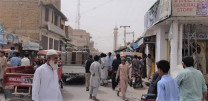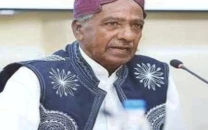Coastal calling: Gwadar holds many promises but no water
Provincial govt remains optimistic that the crisis can be overcome.

Coastal calling: Gwadar holds many promises but no water
Gwadar, Balochistan’s winter capital and the city of countless promises, has yet to give its residents a sufficient supply of water.
The port city is supplied two million gallons of water every four days, against a daily requirement of 3.5 million gallons, official data suggests.
“Water comes here after every four days,” says Haji Aslam from the Public Health Engineering department. “We are rationing water supply from the dam so that it lasts at least a month,” he adds cautiously.
The port city has a long history of water crisis.
The Ankara Kaur Dam, built in 1993 and stretching over an area of 17,000 acres, remains the sole source of water supply to inhabitants. The crisis worsened in 2006 as population increased.
Gwadar town and Jawani, constituting 50 per cent of the total population of Gwadar district, rely on the Ankara Kaur Dam for all their water needs. Residents of the other three coastal towns of Pasni, Ormara and Sunt Sar are dependant upon seasonal rivers for meeting their demand.
The citizens, meanwhile, decry the utter failure of authorities to come up with a viable solution to the problem.
“There are always tall claims about developing Gwadar city, but in truth we are deprived of basic necessities,” says a resident Hafeez Dashti. “The government is doing nothing except making false claims. Gwadar has been suffering from an acute water shortage for the past decade, but no concrete steps have been taken to overcome this problem.”
Failing infrastructure
The water level in the dam is decreasing because of silt accumulation, another official said. “The amount of accumulated silt betrays the fact that the dam is past more than 50 per cent of its useful life,” he said.
The previous government planned to install a water desalination plant in
Pasni and Jiwani. Around Rs2 billion were also earmarked for infrastructural investments. However, according to citizens, the funds were embezzled later on.
Govt remains optimistic
The incumbent provincial government, however, remains optimistic that they can overcome the crisis.
“We have taken up this issue with the chief minister who visited Gwadar recently. He not only approved several water projects but also directed authorities concerned to expedite their efforts,” says Hamal Kalmati, provincial minister for fisheries, elected to the provincial assembly from Gwadar.
According to Kalmati, the Balochistan government has approved Rs4 billion for Shadi Kaur Dam and another Rs2 billion for Sawad Dam, both of which are currently under construction.
Besides this, the Balochistan Development Authority (BDA) has also installed a desalination plant in Gwadar at a cost of Rs1 billion. “This will be functional soon and will provide two million gallons per day to inhabitants,” Kalmati adds.
To avert the crisis in the short term, a plan to connect Gwadar with the Mirani Dam in Kech district is also doing the rounds. However, according to Kalmati, the political administration in Kech is against the move.
Judging from the government’s position, it would seem that no stones are being left unturned to overcome the problem.
Kalmati recently arranged a special prayer for rains in Gwadar too. When Gwadar’s citizens are asked, they seem to have more faith in the heavens opening up the gates because as of now, a well thought out public policy plan to address water shortage seems far off.
Published in The Express Tribune, March 20th, 2012.



















COMMENTS
Comments are moderated and generally will be posted if they are on-topic and not abusive.
For more information, please see our Comments FAQ